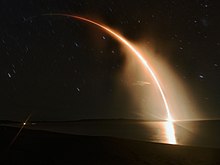CAPSTONE
The spacecraft is a 12-unit CubeSat that is also testing a navigation system that is measuring its position relative to NASA's Lunar Reconnaissance Orbiter (LRO) without relying on ground stations.
The Gateway is planned to be placed in a novel lunar orbit that had never been used until CAPSTONE, where it is expected to serve as a communications hub, science laboratory, short-term habitation module, and holding area for rovers and other robots.
[8] The main objective of the CAPSTONE mission is to verify the theoretical orbital stability simulations for the Gateway with an actual spacecraft.
However, certification of the Autonomous Flight Termination System (AFTS) took longer than anticipated, resulting in the launch site being changed to Mahia.
[17] By 30 September, CAPSTONE was "power positive" and on a stable trajectory towards the Moon while the mission operators worked to regain orientation control of the spacecraft.
[21] After being ejected from Earth orbit by a series of burns of the Photon stage, the spacecraft reached a distance of about 1.5 million kilometers, where perturbations from the Sun became important.
